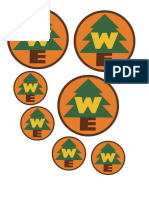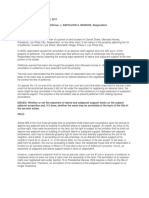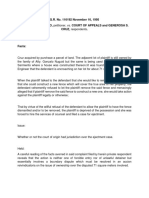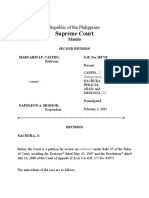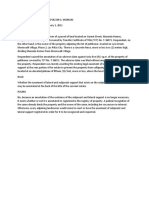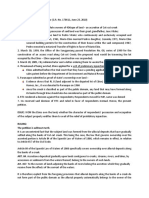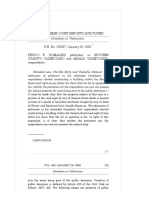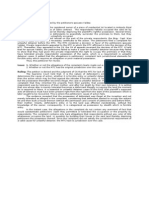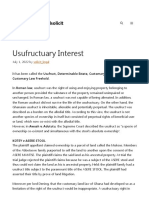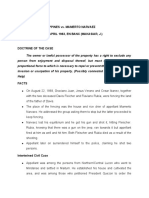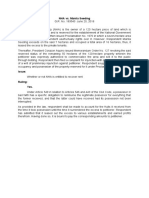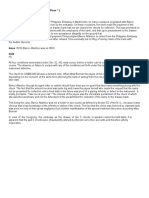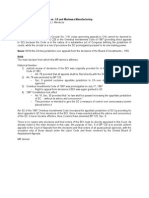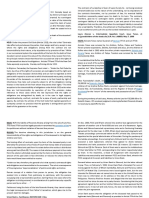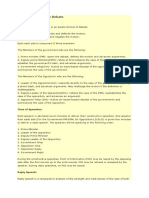Castro V Monsod
Castro V Monsod
Uploaded by
Nap GonzalesCopyright:
Available Formats
Castro V Monsod
Castro V Monsod
Uploaded by
Nap GonzalesOriginal Description:
Original Title
Copyright
Available Formats
Share this document
Did you find this document useful?
Is this content inappropriate?
Copyright:
Available Formats
Castro V Monsod
Castro V Monsod
Uploaded by
Nap GonzalesCopyright:
Available Formats
CASTRO VS.
MONSODFACTS:
Petitioner is the registered owner of a parcel of landwith an area of 130 sq.m. while respondent is theowner of the
property adjoining the lot of petitioner.
Respondent caused the annotation of an adverseclaim against 65 sq.m. of the property of petitioner. The adverse claim
was filed without any claim of ownership over the property. Respondent was merelyasserting the existing legal
easement of lateral andsubjacent support at the rear portion of his estate toprevent the property from collapsing, since
hisproperty is located at an elevated plateau of fifteen15 feet above the level of petitioners property
Prior to the filing of the case, petitioner noticed aleak that caused the front portion of her house to beslippery, she hired
construction workers to see wherethe leak was coming from. The workers had alreadystarted digging when police
officers sent byrespondent came and stopped the workers fromfinishing their job..
In defiance, petitioner filed a complaint for damageswith temporary restraining order/writ of preliminaryinjunction.
Respondent alleged that the elevated part of Manuela homes (location of the property of petitioner) were bulldozed,
excavated, andtransferred portions of the elevated land to the lowerportions of Manuela Homes. Thus, Manuela Homes
became lowerthan Moonwalk Village (location of the property of respondent).
Before the said excavation, respondent personallycomplained to Pilar Development Corporation andwas assured that an
embankment will be retained atthe boundary of Manuela Homes and MoonwalkVillage.
Manuela Homes retained the embankment consistingof soil and rocks. Respondent had the open spaceriprapped with
stones as reinforcement against anypotential soil erosion, earthquake, and possibledigging by any person. RTC rendered
a decision in favor of the petitionerOn appeal, the CA reversed the decision of the trial courtexplaining that the purpose
of the annotation was to
prevent petitioner from making injurious excavations on thesubject embankment as to deprive the residential houseand
lot of respondent of its natural support and cause it tocollapse. Respondent only asked that petitioner respect thelegal
easement already existing thereon.
ISSUE: Whether the easement of lateral andsubjacent support exists on the subject adjacentproperties and, if it does,
whether the same may beannotated at the back of the title of the servientestate.HELD: YES. Article 437 of the Civil Code
provides that the ownerof a parcel of land is the owner of its surface and of everything under it, and he can construct
thereonany works, or make any plantations and excavationswhich he may deem proper. However, such right of the
owner is not absolute and is subject to thefollowing limitations: (1) servitudes oreasements, (2) special laws, (3)
ordinances, (4)reasonable requirements of aerial navigation, and(5) rights of third persons
.His reason for the annotation is only to prevent petitionerfrom removing the embankment or from digging on
theproperty for fear of soil erosion that might weaken thefoundation of the rear portion of his property which isadjacent
to the property of petitioner.
An easement or servitude is an encumbranceimposed upon an immovable for the benefit of another immovable
belonging to a different owner.
An easement is established either by law or by will of theowners. The courts cannot impose or constitute anyservitude
where none existed. They can only declare itsexistence if in reality it exists by law or by the will of theowners. There are
therefore no judicial easements. Article 684 of the Civil Code provides that no proprietorshall make such excavations
upon his land as to depriveany adjacent land or building of sufficient lateral orsubjacent support. An owner, by virtue of
his surface right,may make excavations on his land, but his right is subjectto the limitation that he shall not deprive any
adjacent landor building of sufficient lateral or subjacent support.Between two adjacent landowners, each has an
absoluteproperty right to have his land laterally supported by thesoil of his neighbor, and if either, in excavating on his
ownpremises, he so disturbs the lateral support of hisneighbors land as to cause it, or, in its natural state, by
thepressure of its own weight, to fall away or slide from itsposition, the one so excavating is liableIn the instant case, an
easement of subjacent andlateral support exists in favor of respondent. It was
established that the properties of petitioner and respondentadjoin each other. The residential house and lot of
respondent is located on an elevated plateau of fifteen (15)feet above the level of petitioners property.
Theembankment and the riprapped stones have been inexistence even before petitioner became the owner of
theproperty. It was proven that petitioner has been makingexcavations and diggings on the subject embankment
and,unless restrained, the continued excavation of theembankment could cause the foundation of the rear portionof
the house of respondent to collapse, resulting in thedestruction of a huge part of the family dwelling
An annotation of the existence of the subjacent andlateral support is no longer necessary. It existswhether or not it is
annotated or registered in theregistry of property. A judicial recognition of thesame already binds the property and the
owner of the same, including her successors-in-interest
.Otherwise, every adjoining landowner would come to courtor have the easement of subjacent and lateral
supportregistered in order for it to be recognized and respected
You might also like
- Russell Costume BadgesDocument4 pagesRussell Costume BadgesNap Gonzales100% (1)
- 6th Central Pay Commission Salary CalculatorDocument15 pages6th Central Pay Commission Salary Calculatorrakhonde100% (436)
- SJF28 - Joint Event Medical and Consent Form-1Document5 pagesSJF28 - Joint Event Medical and Consent Form-1Caitkat0No ratings yet
- Castro vs. MonsodDocument3 pagesCastro vs. Monsodamun dinNo ratings yet
- Lateral SupportDocument3 pagesLateral SupportGia Dimayuga100% (1)
- Assignment No.3 - Case Digest - Legal CounsellingDocument5 pagesAssignment No.3 - Case Digest - Legal CounsellingglennNo ratings yet
- Mactan Workers Union v. AboitizDocument1 pageMactan Workers Union v. AboitizNap GonzalesNo ratings yet
- Corruption Is A Big Menace in PakistanDocument7 pagesCorruption Is A Big Menace in PakistanIrfan Baloch100% (1)
- Bullet Proof ManagerDocument29 pagesBullet Proof ManagerM R Singhal100% (1)
- Castro Vs MonDocument3 pagesCastro Vs MonAnonymous qjsSkwFNo ratings yet
- Easement Against Nuisance and Adjacent Subjacent SupportDocument5 pagesEasement Against Nuisance and Adjacent Subjacent SupportlumengggNo ratings yet
- MARGARITA F. CAstro vs. Napoleon A. MonsodDocument2 pagesMARGARITA F. CAstro vs. Napoleon A. MonsodSkipper CabahugNo ratings yet
- Case Digest. MonsodDocument4 pagesCase Digest. MonsodReghEllorimoNo ratings yet
- Castro V MonsodDocument2 pagesCastro V MonsodweeNo ratings yet
- Margarita F Castro Vs Napoleon A MonsodDocument3 pagesMargarita F Castro Vs Napoleon A Monsodwesternwound82No ratings yet
- Case Digest Castro Vs Monsod Plana GCMDocument2 pagesCase Digest Castro Vs Monsod Plana GCMGilvee Plana100% (1)
- OK 2. OK 3. OK But No Explanation 4. OK 5. OK 6. OK 7. 8. 9. OK 10. 11. 12. IDocument3 pagesOK 2. OK 3. OK But No Explanation 4. OK 5. OK 6. OK 7. 8. 9. OK 10. 11. 12. IGelloNo ratings yet
- Easements - Lateral and Adjacent Support - REPORTDocument40 pagesEasements - Lateral and Adjacent Support - REPORTMikhail Ambrose AggabaoNo ratings yet
- Right To Support.Document4 pagesRight To Support.ARJOON AMALOURDE RAJNo ratings yet
- Sarmiento Vs CADocument2 pagesSarmiento Vs CAErika Angela GalceranNo ratings yet
- LAW OF IMMOVABLE PROPERTY NotesDocument10 pagesLAW OF IMMOVABLE PROPERTY NotesFrancis OwusuNo ratings yet
- Castro v. Monsod. GR 183719, Feb. 2, 2011, 641 SCRA 486Document1 pageCastro v. Monsod. GR 183719, Feb. 2, 2011, 641 SCRA 486Gia DimayugaNo ratings yet
- Full Cases in Land, Titles and DeedsDocument54 pagesFull Cases in Land, Titles and Deedsemman2g.2baccayNo ratings yet
- Easements Outline PDFDocument33 pagesEasements Outline PDFmickayla jonesNo ratings yet
- Civil Law 1 - Finals - AnsDocument5 pagesCivil Law 1 - Finals - AnsFrank Gernale GolpoNo ratings yet
- ANDRES VS STA. LUCIA REALTY DEVELOPMENT INC. (G.R. No. 201405, August 24, 2015)Document15 pagesANDRES VS STA. LUCIA REALTY DEVELOPMENT INC. (G.R. No. 201405, August 24, 2015)Sean Pamela BalaisNo ratings yet
- Castro v. MonsodDocument1 pageCastro v. MonsodCases M7No ratings yet
- Castro VS Monsod 183719Document7 pagesCastro VS Monsod 183719chai seneresNo ratings yet
- Case Things To Remember ClassificationsDocument5 pagesCase Things To Remember ClassificationsPatrick PenachosNo ratings yet
- Trespass NotesDocument30 pagesTrespass Notesjohnny naloNo ratings yet
- Easement Cases DigestDocument33 pagesEasement Cases DigestQUEEN NATALIE TUASONNo ratings yet
- TECHNOGAS Vs CADocument11 pagesTECHNOGAS Vs CANovie Grace DuquillaNo ratings yet
- Office of The City Mayor V Ebio DigestDocument2 pagesOffice of The City Mayor V Ebio DigestJedskii RosalNo ratings yet
- 4.1 - Domalsin vs. Valenciano (2006)Document23 pages4.1 - Domalsin vs. Valenciano (2006)Meg ReyesNo ratings yet
- FLORES VS BAGAOISAN (G.R. No. 173365, April 15, 2010)Document4 pagesFLORES VS BAGAOISAN (G.R. No. 173365, April 15, 2010)Datu TahilNo ratings yet
- Property Week 11Document27 pagesProperty Week 11Kikoy IlaganNo ratings yet
- Case No. 28 Topic: Principle of Self Help and State of NecessityDocument7 pagesCase No. 28 Topic: Principle of Self Help and State of NecessityEizel RamosNo ratings yet
- Case Digests For Easement (1, 12, 23)Document4 pagesCase Digests For Easement (1, 12, 23)Apay GrajoNo ratings yet
- 5TH 5 CasesDocument7 pages5TH 5 CasesDolceNo ratings yet
- TECHNOGAS PHIL Vs CADocument2 pagesTECHNOGAS PHIL Vs CANina CastilloNo ratings yet
- Property Additional Case Based On Recent JurisprudenceDocument54 pagesProperty Additional Case Based On Recent Jurisprudencelex omniaeNo ratings yet
- Bar Q & A in Property: Illegal and Impossible Conditions in An Onerous DonationDocument43 pagesBar Q & A in Property: Illegal and Impossible Conditions in An Onerous DonationPing Tengco Lopez100% (6)
- Property Compilation of Case Digests 1.Document34 pagesProperty Compilation of Case Digests 1.marc molinaNo ratings yet
- 10 Jose v. AlfuertoDocument2 pages10 Jose v. AlfuertoSarah GantoNo ratings yet
- TECHNOGAS PHIL Vs CADocument3 pagesTECHNOGAS PHIL Vs CAJf ManejaNo ratings yet
- City Mayor of Paranaque v. EbioDocument2 pagesCity Mayor of Paranaque v. EbioGillian CalpitoNo ratings yet
- Property Law DigestDocument5 pagesProperty Law DigestHurjae Soriano LubagNo ratings yet
- Effects of Possession Cases DoctrinesDocument16 pagesEffects of Possession Cases DoctrinessaraNo ratings yet
- Easements Land Law 2Document7 pagesEasements Land Law 2ABDOULIE100% (1)
- Villanueva VS. Velasco: G.R. No. 130845 November 27, 2000 Legal EasementDocument6 pagesVillanueva VS. Velasco: G.R. No. 130845 November 27, 2000 Legal Easementracel joyce gemotoNo ratings yet
- Law of Torts ProjectDocument15 pagesLaw of Torts ProjectAnjali SinghNo ratings yet
- Cajayon Vs - Spouses Batuyong G.R. No. 149118 February 16, 2006 Tinga, J.: FactsDocument2 pagesCajayon Vs - Spouses Batuyong G.R. No. 149118 February 16, 2006 Tinga, J.: FactsKier ArqueNo ratings yet
- Property First QuizDocument4 pagesProperty First QuizJumen Gamaru TamayoNo ratings yet
- Right of Accession Case DigestsDocument10 pagesRight of Accession Case DigestsTina SiuaganNo ratings yet
- SPA. DE LA CRUZ v. RAMISCALDocument1 pageSPA. DE LA CRUZ v. RAMISCALMacy TangNo ratings yet
- Alvaro Vs Zapata DigestDocument2 pagesAlvaro Vs Zapata DigestJayson Lloyd P. Maquilan0% (1)
- Valdez vs. CADocument1 pageValdez vs. CAsandy522No ratings yet
- Land Law Book of CasesDocument19 pagesLand Law Book of Caseschristabel.osei003No ratings yet
- Usufructuary Interest - LegalsolicitDocument12 pagesUsufructuary Interest - LegalsolicitCarlos BrownNo ratings yet
- People of The Philippines vs. Mamerto Narvaez G.R. No. L-33466-6720 APRIL 1983, EN BANC (MAKASIAR, J.)Document4 pagesPeople of The Philippines vs. Mamerto Narvaez G.R. No. L-33466-6720 APRIL 1983, EN BANC (MAKASIAR, J.)Beya AmaroNo ratings yet
- Property DigestDocument176 pagesProperty DigestArianeNo ratings yet
- Facts:: Technogas Philippines v. Court of Appeals, G.R. No. 108894. February 10, 1997Document2 pagesFacts:: Technogas Philippines v. Court of Appeals, G.R. No. 108894. February 10, 1997JoyNo ratings yet
- NHA vs. Manila Seeding FactsDocument5 pagesNHA vs. Manila Seeding FactsLaindei Lou TorredaNo ratings yet
- Constitution of the State of Minnesota — 1964 VersionFrom EverandConstitution of the State of Minnesota — 1964 VersionNo ratings yet
- Constitution of the State of Minnesota — 1960 VersionFrom EverandConstitution of the State of Minnesota — 1960 VersionNo ratings yet
- 1951 Refugee ConventionDocument56 pages1951 Refugee ConventionNap GonzalesNo ratings yet
- Republic Vs East Silver LaneDocument4 pagesRepublic Vs East Silver LaneNap GonzalesNo ratings yet
- Republic v. Sese (2014)Document2 pagesRepublic v. Sese (2014)Nap Gonzales100% (1)
- 2019 2020 Application For TheDocument13 pages2019 2020 Application For TheNap GonzalesNo ratings yet
- Samson v. RestriveraDocument5 pagesSamson v. RestriveraNap GonzalesNo ratings yet
- 2020 - 2021 Philippine Fulbright Graduate Student Program: Fields of StudyDocument11 pages2020 - 2021 Philippine Fulbright Graduate Student Program: Fields of StudyNap GonzalesNo ratings yet
- Teotico vs. Del ValDocument2 pagesTeotico vs. Del ValNap GonzalesNo ratings yet
- Banco Atlantico v. Auditor GeneralDocument1 pageBanco Atlantico v. Auditor GeneralNap GonzalesNo ratings yet
- AFP Retirement and Separation Benefits System v. RepublicDocument2 pagesAFP Retirement and Separation Benefits System v. RepublicNap GonzalesNo ratings yet
- Rodelas v. Aranza (1982)Document2 pagesRodelas v. Aranza (1982)Nap GonzalesNo ratings yet
- Yu VS NLRCDocument2 pagesYu VS NLRCNap GonzalesNo ratings yet
- Canque Vs CADocument3 pagesCanque Vs CANap GonzalesNo ratings yet
- Manila Fashions v. NLRC (1996)Document2 pagesManila Fashions v. NLRC (1996)Nap Gonzales100% (1)
- Rojas Vs MaglanaDocument2 pagesRojas Vs MaglanaNap Gonzales100% (1)
- Lange Vs BartlettDocument2 pagesLange Vs BartlettNap GonzalesNo ratings yet
- Mahan V MahanDocument2 pagesMahan V MahanNap GonzalesNo ratings yet
- Villareal V RamirezDocument2 pagesVillareal V RamirezNap GonzalesNo ratings yet
- Philippine Realty V Ley ConstructionDocument2 pagesPhilippine Realty V Ley ConstructionNap GonzalesNo ratings yet
- Lemay Bank Vs LawrenceDocument2 pagesLemay Bank Vs LawrenceNap GonzalesNo ratings yet
- Aragon V CADocument1 pageAragon V CANap GonzalesNo ratings yet
- Severino Vs SeverinoDocument2 pagesSeverino Vs SeverinoNap Gonzales100% (1)
- Cruz V MijaresDocument2 pagesCruz V MijaresNap Gonzales100% (2)
- Kapisanan v. Yard Crew (1960)Document2 pagesKapisanan v. Yard Crew (1960)Nap GonzalesNo ratings yet
- ST Martin Funeral Home Vs NLRCDocument2 pagesST Martin Funeral Home Vs NLRCNap GonzalesNo ratings yet
- First Lepanto vs. CADocument1 pageFirst Lepanto vs. CANap GonzalesNo ratings yet
- Woodchild V RoxasDocument2 pagesWoodchild V RoxasNap Gonzales100% (2)
- British Airways v. CA and Mahtani and PALDocument2 pagesBritish Airways v. CA and Mahtani and PALNap GonzalesNo ratings yet
- Agreement: Wosen Melese General Contractor G+3 Three Bed Rooms Typology BUILDING ConstructionDocument5 pagesAgreement: Wosen Melese General Contractor G+3 Three Bed Rooms Typology BUILDING ConstructionJeji HirboraNo ratings yet
- Maladaptive DaydreamingDocument8 pagesMaladaptive DaydreamingMalak ZiyadNo ratings yet
- Dimensions of EthicsDocument3 pagesDimensions of Ethicsbipin09103034100% (1)
- Doctrine of Primary Jurisdiction - MidtermsDocument21 pagesDoctrine of Primary Jurisdiction - MidtermsAnny YanongNo ratings yet
- Villalobos Ethics Argument EssayDocument10 pagesVillalobos Ethics Argument Essayapi-727275001No ratings yet
- Wills Hemady GoOngDocument19 pagesWills Hemady GoOngMatthew WittNo ratings yet
- Human RightsDocument43 pagesHuman Rightslucy_115No ratings yet
- Case Concerning Electronica SiculaDocument9 pagesCase Concerning Electronica SiculaasepkusnaliNo ratings yet
- Rational and Irrational BeliefsDocument3 pagesRational and Irrational BeliefsL SNo ratings yet
- Asian Parliamentary DebateDocument19 pagesAsian Parliamentary DebateDanielle Dyne Deloso CagaananNo ratings yet
- Top 88 Divorce TipsDocument16 pagesTop 88 Divorce TipsSLAVEFATHERNo ratings yet
- Presentación Cap. Mike WatsonDocument9 pagesPresentación Cap. Mike WatsonConselho Nacional de PraticagemNo ratings yet
- Chua Video QuizDocument2 pagesChua Video QuizSteffi Loren ChuaNo ratings yet
- 1Document68 pages1Rizky ArifNo ratings yet
- Oliveira Pinho 2008 CITTADocument20 pagesOliveira Pinho 2008 CITTARajesh SahooNo ratings yet
- Case Planning Chart FinalDocument2 pagesCase Planning Chart FinalVaibhav SinghNo ratings yet
- Theology MidtermsDocument4 pagesTheology MidtermsAngelica Mae De LeonNo ratings yet
- HIJAB Is There in Hindu and Christian Books AlsoDocument3 pagesHIJAB Is There in Hindu and Christian Books AlsoMehboob HassanNo ratings yet
- Sale and Purchase Contract For Magnetite Iron SandDocument6 pagesSale and Purchase Contract For Magnetite Iron SandM. Ghufron PringgodaniNo ratings yet
- Strategic Alliance vs. Radstock Securities PDFDocument2 pagesStrategic Alliance vs. Radstock Securities PDFrapgracelim100% (1)
- Executive Order PraiseDocument3 pagesExecutive Order PraiseSamantha DiezNo ratings yet
- DM68 s2022 Launching of The SIKAT For Teaching and Non Teaching EmployeesDocument13 pagesDM68 s2022 Launching of The SIKAT For Teaching and Non Teaching EmployeessherileneNo ratings yet
- Stopping by Woods On A Snowy EveningDocument5 pagesStopping by Woods On A Snowy EveningMy WorkNo ratings yet
- An Inspector Calls - Essay Grade 9Document9 pagesAn Inspector Calls - Essay Grade 9samirmayaniNo ratings yet
- Ijma and IjtehadDocument38 pagesIjma and IjtehadkhudabakshNo ratings yet
- The Hasty Generalization FallacyDocument11 pagesThe Hasty Generalization Fallacyapi-305353119No ratings yet
- Things Fall Apart: Colonial Nigeria Had Its Own Fundamental Flaws That Went Against The Development of SocietyDocument2 pagesThings Fall Apart: Colonial Nigeria Had Its Own Fundamental Flaws That Went Against The Development of SocietyIJAR JOURNALNo ratings yet
